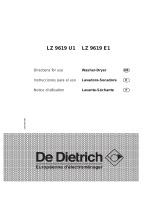Assembling the chimney
Hood to be used with external evacuation: fig. 5 and 9
- Attach the metal chimney bracket to the wall, also placing this against the ceiling (fig. 7).
- In the case of a flue with a diameter of 125 mm, use the adapter supplied (fig.9).
If your exterior duct is below 125 mm, you must obligatorily connect your hood
in recycling mode.
- Prepare your telescopic chimney, taking care to block off the vents (fig. 9).
Fit the chimneys into one another as far as they will go.
- Fit the upper part to the metal bracket (fig. 9).
- Adjust the length of the telescopic chimney by bringing down the lower part and fitting it
to the top of the hood (fig. 9).
Hood to be used in "recycling" mode: fig. 6 and 10
- Attach the metal chimney bracket against the wall, also placing this against the ceiling.
Take care to centre the deflector vis-à-vis the vertical line drawn on the wall (fig. 7).
- Place and screw the deflector plate to the chimney where the vents are located (fig. 8).
- Prepare your chimney, taking care to block off the vents so that they are visible (fig. 9).
- Attach the upper part to the metal chimney bracket.
- Adjust the length of the telescopic chimney by bringing down the lower part and fitting it into
the top of the hood.
To ensure optimal use of your device, we advise that you connect a flue with
a diameter of 150 mm (not supplied). Limit the number of angles and bends
as far as possible, and keep the length of the flue to a minimum. In the event
that the hood will be functioning using exterior evacuation, you should ensure
a sufficient inlet of fresh air to avoid a pressure deficiency in the room.
Changing the lamp?
1. Remove metal filters (fig. 11).
2. Unscrew then change the E14-40W bulb (fig. 12).
3. Replace the metal filters.
Before carrying out any work, the power supply to the hood must be turned
off, either by unplugging it or by using the circuit breaker switch.




















